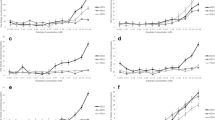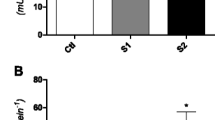Abstract
Substantial efforts have been devoted to developing and applying biomarkers for ecological risk assessment. Bivalve mollusks, such as mussels and oysters, are commonly used in environmental monitoring programs because of their wide geographical distribution, great sensitivity to environmental pollutants, and ability to accumulate anthropogenically derived chemicals at a high rate. Acetylcholinesterase (AChE) activity and metallothionein (MT’s) content are representative specific biomarkers that indicate the presence of anticholinesterasic compounds (like organophosphorus and carbamate pesticides) and metals, respectively. The aim of this study was to evaluate AChE activity and MT’s content in Crassostrea corteziensis from Boca de Camichín estuary. The results obtained here showed that AChE activity was 65% lower in oysters from Boca de Camichín than in control organisms. In contrast, MT’s content in collected organisms was not statistically different from that in control organisms. AChE activity and MT’s content in oysters could be used as early biomarkers of effects and exposure to pesticides and heavy metals, respectively, in aquatic environments.





Similar content being viewed by others
References
Baer KN, Thomas P (1990) Influence of capture stress, salinity and reproductive status on zinc associated with metallothionein-like-proteins in the liver of three teleost species. Mar Environ Res 29:277–287
Baudrimont M, Metivaud J, Maury-Brachet R, Ribeyre F, Boudou A (1997) Bioaccumulation and metallothionein response in the Asiatic clam (Corbicula fluminea) after experimental exposure to cadmium and inorganic mercury. Environ Toxicol and Chem 16:2096–2106
Bebianno MJ, Nott JA, Langston WJ (1993) Cadmium metabolism in the clam Ruditapes decusata: the role of metallothioneins. Aquat Toxicol 27:315–334
Binelli A, Ricciard F, Riva C, Provini A (2006) Integrated use of biomarkers and bioaccumulation data in zebra mussel (Dreissena polymorpha) for site-specific quality assessment. Biomarker 11(5):428–448
Bocquene G, Roig A, Fournier D (1997) Cholinesterases from common oyster (Crassostrea gigas). Evidence for the presence of a soluble acetylcholinesterase insensitive to organophosphate and carbamate inhibitors. FEBS Lett 407(3):261–266
Boening DW (1999) An evaluation of bivalves as biomonitors of heavy metals pollution in marine waters. Environ Monit Assess 55:459–470
Bolton-Warberg M, Coen LD, Weinstein JE (2007) Acute toxicity acetylcholinesterase inhibition in grass shrimp (Palaemonetes pugio) and oysters (Crassostrea virginica) exposed to the organophosphates dichlorvos: laboratory and field studies. Arch Environ Contam Toxicol 52(2):207–216
Bremner I (1987) Nutritional and physiological significance of metallothionein. Experientia Suppl 52:61–107
Cajaraville MP, Bebianno MJ, Blasco J, Porte C, Sarasquete C, Viarengo A (2000) The use of biomarkers to assess the impact of pollution in coastal environments of the Iberian Peninsula: a practical approach. Sci Total Environ 247:295–311
Ceratto N, Dondero F, Loo JW, Burlando B, Viarengo A (2002) Cloning and sequencing of a novel metallothionein gene in Mytilus galloprovincialis. Lam Comp Biochem Physiol C 131:217–222
Cosson RP, Amiard JC (2000) Use of metallothioneins as biomarkers of exposure to metals. In: Lagadic L, Caquet T, Amiard JC, Ramade F (eds) Use of biomarkers for environmental quality assessment, New Hampshire: science publishers. Enfield, New Hampshire, pp 79–111
Damiens G, His E, Gnassia BM, Quiniou F, Roméo M (2004) Evaluation of biomarkers in oyster larvae in natural and polluted conditions. Comp Biochem Physiol C Toxicol Pharmacol 138(2):121–128
Ellman G, Courtney KD, Andres V Jr, Feather-Stone RM (1961) A new and rapid colorimetric determination of acetylcholinesterase activity. Biochem Pharmacol 7:88–95
English TE, Storey KB (2003) Freezing and anoxia stresses induce expression of metallothionein in the foot muscle and hepatopancreas of the marine gastropod Littorina littorea. J Exp Biol 206:2517–2524
Escartín E, Porte C (1997) The use of cholinesterase and carboxylesterase activities from Mytilus galloprovincialis in pollution monitoring. Environ Toxicol Chem 16:2090–2095
Forbes VE, Palmqvist A, Bach L (2006) The use and misuse of biomarkers in ecotoxicology. Environ Toxicol Chem 25:272–280
Fulton MH, Key PB (2001) Acetylcholinesterase inhibition in estuarine fish and invertebrates as an indicator of organophosphorus insecticide exposure and effects. Environ Toxicol Chem 20(1):37–45
Geffard A, Amiard JC, Amiard-Triquet C (2002) Use of metallothionein in gills from oysters (Crassostrea gigas) as a biomarker: seasonal and intersite fluctuations. Biomarkers 7(2):123–137
Geffard A, Amiard-Triquet C, Amiard JC, Mouneyrac C (2001) Temporal variations of metallothionein and metal concentrations in the digestive gland of oysters Crassostrea gigas from a clean and a metal-rich site. Biomarkers 6(2):91–107
George SG, Olsson PE (1994) Metallothioneins as indicators of trace metal pollution. In: Krame KJM (ed) Biomonitoring of coastal waters and estuaries. CRC Press, Boca Raton, pp 151–178
Huggett RJ, Kimerle RA, Mehrle PM Jr, Bergman HL (1992) Biomarkers: biochemical, physiological and histological markers of anthropogenic stress. Lewis, Boca Raton
Hyne RV, Maher WA (2003) Invertebrate biomarkers: links to toxicosis that predict population decline. Ecotoxicol Environ Saf 54(3):366–374
Kagi JHR (1993) Evolution, structure, and chemical activity of class I metallothioneins: an overview. In: Susuki KT, Imura N, Kimura M (eds) Metallothionein III: biological roles and medical implications. Birkhauser Verlag, Basel, pp 29–55
Kimura M, Otaki N, Imano M (1979) Rabbit liver metallothionein. Tentative amino acid sequence of metallothionein-B. Experientia Suppl 34:163–168
Kumar A, Sharma B, Pandey R (2009) λ-cyhalothrin and cypermethrin induced in vivo alterations in the activity of acetylcholinesterase in a freshwater fish, Channa punctatus (Bloch). Pesticide Biochem Physiol (USA) 93:96–99. doi:10.1016/j.pestbp.2008.12.005
Langston WJ, Bebianno MJ, Burt GR (1998) Metal handling strategies in molluscs. In: Langston WJ, Bebianno MJ (eds) Metal metabolism in aquatic environments. Chapman and Hall, London, pp 219–283
Le Bris H, Maffart P, Bocquené G, Buchet V, Galgani F, Blanc G (1995) Laboratory study on the effect of dichlorvos on two commercial bivalves. Aquaculture 138:139–144
Lowe TP, Day DD (2002) Metal concentrations in zebra mussels and sediments from embayments and riverine environments of eastern Lake Erie, southern Lake Ontario and the Niagara River. Arch Environ Contam Toxicol 43:301–308
Lowry O, Rosebrough NJ, Farr AL, Raldall RJ (1951) Protein measurement with the Folin phenol reagent. J Biol Chem 193(1):265–275
Mackay EA, Overnell J, Dunbar B, Davidson I, Hunziker P, Kagi JH, Fothergill JE (1993) Complete amino acid sequences of five dimeric and four monomeric forms of metallothionein from the edible mussel Mytilus edulis. Eur J Biochem 218:183–194
Monserrat JM, Bianchini A, Bainy AC (2002) Kinetic and toxicological characteristics of acetylcholinesterase from the gills of oysters (Crassostrea rhizophorae) and other aquatic species. Environ 54(3–5):781–785
Mora P, Fournier D, Narbonne JF (1999) Cholinesterases from the marine mussels Mytilus galloprovincialis Lmk. and M. edulis L. and from the freshwater bivalve Corbicula fluminea Muller. Comp Biochem Physiol C Pharmacol Toxicol Endocrinol 122(3):353–361
Mosleh YY, Paris-Palacios S, Arnoult F, Couderchet M, Biagianti-Risbourg S, Vernet G (2004) Metallothionein induction in aquatic oligochaete Tubifex tubifex exposed to herbicide isoproturon. Environ Toxicol 19:88–93
Mouneyrac C, Amiard JC, Amiard-Triquet C (1998) Effects of natural factors (salinity and body weight) on cadmium, copper, zinc and metallothionein-like protein levels in resident populations of oysters Crassostrea gigas from a polluted estuary. Mar Ecol Prog Ser 162:125–135
Pérez E, Blasco J, Solé M (2004) Biomarker responses to pollution in two invertebrate species: Scrobicularia plana and Nereis diversicolor from the Cádiz bay (SW Spain). Mar Environ Res 58(2–5):275–279
Piano A, Valbonesi P, Fabbri E (2004) Expression of cytoprotective proteins, head shock protein 70 and metallothioneins, in tissues of Ostea edulis exposed to head and heavy metals. Cell Stress Chaperones 9(2):134–142
Radenac G, Bocquené G, Fichet D, Miramand P (1998) Contamination of a dredged- material disposal site (La Rochelle Bay, France). The use of the acetylcholinesterase activity of Mytilus edulis as a biomarker of pesticides: the need for a critical approach. Biomarkers 3:305–315
Raspor B, Erk M, Pavicic J, Juric D, Kwokal Z, Odzak N (1999) Metallothionein as biomarker of mussel exposure to heavy metals. Marine Pollution. 151–156
Robledo-Marenco ML, Botello AV, Romero-Bañuelos CA, Díaz-González G (2006) Presence of persistent organochlorine pesticides in estuaries of the subtropical Mexican Pacific. Int J Environment and Pollution 26(1/2/3):284–294
Roesijadi G (1994a) Metallothionein induction as a measure of response to metal exposure in aquatic animals. Environ Health Perspect 102:91–95
Roesijadi G (1994b) Behavior of metallothionein-bound metals in a natural population of an estuarine mollusc. Mar Environ Res 38:147–168
Sharma B, Gopal K, Khanna YP (1993) Interaction of carbaryl with acetylcholinesterase from the fresh water teleost, Clarias batrachus. Toxicol Environ Chem 39:147–152
Singh RK, Sharma B (2005) Sub-acute toxicity of carbofuran on acetylcholinesterase activity in the freshwater catfish, Clarias batrachus. J Environ Occup Medicine 22(5):403–407
Templeton DM, Cherian MG (1991) Toxicological significance of metallothionein. Meth Enzymol 205:11–24
Thompson HM (1991) Serum B esterase’s as indicators of exposure to pesticides. In: Mineau P (ed) Cholinesterase-inhibiting insecticides chemicals in agriculture. Elsevier, Amsterdam, pp 109–125
Vasak M (1991) Metal removal and substitution in vertebrate and invertebrate metallothioneins. Methods Enzymol 205:452–458
Vergani L, Grattarola M, Borghi C, Dondero F, Viarengo A (2005) Fish and molluscan metallothioneins. FEBS J 272(23):6014–6023
Viarengo A (1989) Heavy metals in marine invertebrates: mechanisms of regulation and toxicity at cellular level. Crit Rev Aquat Sci 1:295–317
Viarengo A, Burlando B, Cavaletto M, Marchi B, Ponzano E, Blasco J (1999) Role of metallothionein against oxidative stress in the mussel Mytilus galloprovincialis. Am J Physiol 277(6 Pt 2):R1612–R1619
Viarengo A, Ponzano E, Dondero F, Fabbri R (1997) A simple spectrophotometric method for metallothionein evaluation in marine organisms: an application to Mediterranean and Antarctic molluscs. Marine Environ Res 44:69–82
Yadav A, Singh RK, Sharma B (1998) Interaction of carbofuran with acetylcholinesterase from the brain of the teleost, Clarias batrachus. Toxicol Environ Chem 65:245–254
Acknowledgments
The authors thank Ing. Marco Luis Loza for his technical assistance during oyster collection. We also wish to acknowledge the aquaculture production laboratory ACUAIN for providing the algae used to feed the oysters. This research was made possible through grants NAYARIT-2006-C01-66170 and PROMEP/103.5/07/2746.
Author information
Authors and Affiliations
Corresponding author
Rights and permissions
About this article
Cite this article
Bernal-Hernández, Y.Y., Medina-Díaz, I.M., Robledo-Marenco, M.L. et al. Acetylcholinesterase and metallothionein in oysters (Crassostrea corteziensis) from a subtropical Mexican Pacific estuary. Ecotoxicology 19, 819–825 (2010). https://doi.org/10.1007/s10646-009-0459-2
Accepted:
Published:
Issue Date:
DOI: https://doi.org/10.1007/s10646-009-0459-2




